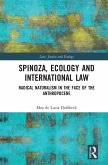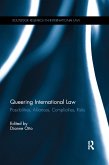Sarah Louise Lothian
Marine Conservation and International Law
Legal Instruments for Biodiversity Beyond National Jurisdiction
Sarah Louise Lothian
Marine Conservation and International Law
Legal Instruments for Biodiversity Beyond National Jurisdiction
- Broschiertes Buch
- Merkliste
- Auf die Merkliste
- Bewerten Bewerten
- Teilen
- Produkt teilen
- Produkterinnerung
- Produkterinnerung
This book provides a blueprint for an International Legally Binding Instrument (ILBI) for the conservation and sustainable use of marine biodiversity beyond national jurisdiction (BBNJ). The development of an ILBI could signify a pivotal turning point in the law of the sea.
Andere Kunden interessierten sich auch für
![International Marine Environmental Law and Policy International Marine Environmental Law and Policy]() International Marine Environmental Law and Policy80,99 €
International Marine Environmental Law and Policy80,99 €![International Environmental Law and the Conservation of Coral Reefs International Environmental Law and the Conservation of Coral Reefs]() Edward J. GoodwinInternational Environmental Law and the Conservation of Coral Reefs68,99 €
Edward J. GoodwinInternational Environmental Law and the Conservation of Coral Reefs68,99 €![Law of Marine Insurance Law of Marine Insurance]() Susan HodgesLaw of Marine Insurance157,99 €
Susan HodgesLaw of Marine Insurance157,99 €![Cases and Materials on Marine Insurance Law Cases and Materials on Marine Insurance Law]() Susan HodgesCases and Materials on Marine Insurance Law170,99 €
Susan HodgesCases and Materials on Marine Insurance Law170,99 €![Spinoza, Ecology and International Law Spinoza, Ecology and International Law]() Moa De Lucia DahlbeckSpinoza, Ecology and International Law64,99 €
Moa De Lucia DahlbeckSpinoza, Ecology and International Law64,99 €![Queering International Law Queering International Law]() Queering International Law64,99 €
Queering International Law64,99 €![The Relationship between Human Security Discourse and International Law The Relationship between Human Security Discourse and International Law]() Shireen DaftThe Relationship between Human Security Discourse and International Law64,99 €
Shireen DaftThe Relationship between Human Security Discourse and International Law64,99 €-
-
-
This book provides a blueprint for an International Legally Binding Instrument (ILBI) for the conservation and sustainable use of marine biodiversity beyond national jurisdiction (BBNJ). The development of an ILBI could signify a pivotal turning point in the law of the sea.
Hinweis: Dieser Artikel kann nur an eine deutsche Lieferadresse ausgeliefert werden.
Hinweis: Dieser Artikel kann nur an eine deutsche Lieferadresse ausgeliefert werden.
Produktdetails
- Produktdetails
- Verlag: Routledge
- Seitenzahl: 322
- Erscheinungstermin: 29. Januar 2024
- Englisch
- Abmessung: 234mm x 156mm x 17mm
- Gewicht: 491g
- ISBN-13: 9781032230429
- ISBN-10: 1032230428
- Artikelnr.: 69936443
- Herstellerkennzeichnung
- Libri GmbH
- Europaallee 1
- 36244 Bad Hersfeld
- gpsr@libri.de
- Verlag: Routledge
- Seitenzahl: 322
- Erscheinungstermin: 29. Januar 2024
- Englisch
- Abmessung: 234mm x 156mm x 17mm
- Gewicht: 491g
- ISBN-13: 9781032230429
- ISBN-10: 1032230428
- Artikelnr.: 69936443
- Herstellerkennzeichnung
- Libri GmbH
- Europaallee 1
- 36244 Bad Hersfeld
- gpsr@libri.de
Sarah Louise Lothian is a Lecturer at the Australian National Centre for Ocean Resources and Security (ANCORS), University of Wollongong, Australia and a Barrister at the New South Wales Bar.
Acknowledgements
List of abbreviations
Introduction
0.1 The development of the law of the sea
0.2 The Grotian doctrine and maritime (flag) States-past and present
0.3 Is the BBNJ process a case of history repeating itself?
0.4 Building bridges between competing positions 7
0.5 Understanding the essential components of an ILBI
0.6 A principled backbone
0.7 An access and benefit-sharing (ABS) regime built on planks of
compromise
0.8 A modern, flexible and compromise approach to MPAs
0.9 Overarching recipe for environmentally sustainable decision-making in
ABNJ
0.10 A sine qua non of the ILBI-capacity-building and technology transfer
(CBTT)
References
1 The promise and limits of international legal protection of BBNJ
Introduction
1.1 Areas beyond national jurisdiction
1.1.1 The geographical scope of the ILBI
1.1.1.1 The high seas
1.1.1.2 The Area
1.2 Marine biological diversity
1.2.1 The material scope of the ILBI
1.2.1.1 The concept of biological diversity
1.2.1.2 Defining marine biodiversity in the ILBI
1.2.2 The significance of BBNJ
1.2.2.1 Hydrothermal vents-oases of life in a submarine desert
1.2.2.2 Seamounts-majestic mountains in the sea 2
1.2.2.3 Cold-water corals (CWCs)-lush gardens in the deep-sea
1.2.3 Ecosystem services
1.3 The troubled waters of ABNJ
1.3.1 Increasing threats from anthropogenic activities
1.3.1.1 Fishing
1.3.1.2 Deep-seabed mining
1.3.1.3 Marine scientific research (MSR)
1.3.1.4 Marine litter
1.3.2 Increasing pressure from climate-associated stressors
1.3.3 Gaps and limitations in the existing international law framework
1.3.3.1 General framework nature of UNCLOS
1.3.3.2 Patchwork of international, regional and sectoral bodies
1.4 A brief historical overview of the BBNJ process
1.4.1 Early developments
1.4.1.1 Ad hoc Open-ended Informal Working Group (BBNJ Working Group)
1.4.1.2 The Preparatory Committee (PrepCom)
1.4.1.3 Intergovernmental Conference (IGC)
1.4.1.4 The current state of play
1.5 Conclusion
References
2 The Grotian tradition and its place in the BBNJ negotiations: Is it a
case of history repeating itself?
Introduction
2.1 The history and formulation of the Grotian doctrine
2.1.1 The dawn of Mare Liberum
2.1.1.1 Ancient origins
2.1.1.2 Dividing the oceans in half-the catalyst for Mare Liberum
2.1.1.3 Open seas versus closed seas-the battle of the books
2.1.1.4 The main components of Mare Liberum
2.1.1.5 Maritime States and Mare Liberum-a special relationship begins
2.1.1.6 The modern codification of the Grotian doctrine
2.2 The Grotian doctrine and the Constitution for the Oceans
2.2.1 How Mare Liberum fits within the UNCLOS framework
2.2.1.1 Freedom of the high seas
2.2.2 A balancing act-open seas versus closed seas
2.2.3 Erosion of the Grotian doctrine
2.3 Freedom of the high seas versus CHM
2.3.1 An unequal freedom
2.3.2 Opposite objectives
2.3.3 The leader of the pack-the US
2.3.4 Unwanted consequences
2.4 The Grotian doctrine's place in the BBNJ negotiations
2.4.1 A feeling of déjà vu?
2.4.2 Freedom of the high seas versus CHM 2.0
2.4.2.1 Freedom of the high seas and MGRs
2.4.2.2 CHM and MGRs
2.4.3 Marine protected areas (MPAs)
2.5 The Grotian doctrine-building block or roadblock?
2.5.1 The only way forward is compromise
2.6 Conclusion
References
3 A principled backbone: The potential role of modern governance principles
and approaches in an ILBI
Introduction
3.1 Compiling a set of modern governance tools
3.1.1 Benefits of a single source
3.1.2 Implementation gaps
3.1.2.1 Protection and preservation of the marine environment
3.1.2.2 The ecosystem approach
3.1.2.3 The precautionary principle
3.1.2.4 The integration approach
3.2 A principle-based approach to the management of ABNJ
3.2.1 Completing the transition to principled ocean governance
3.2.2 Function 1-guides for ocean governance in ABNJ
3.2.3 Function 2-meat for the bones of the BBNJ package deal
3.3 The implementation and operationalisation of governance principles and
approaches through the BBNJ package deal
3.3.1 Turning rhetoric into action
3.3.2 Implementing and operationalising the ecosystem approach through MPAs
3.3.3 Implementing and operationalising the precautionary principle through
EIA
3.3.4 Implementing and operationalising the integration approach through
CBTT
3.4 Conclusion
References
4 A blueprint for Blue Gold: The search for planks of compromise in an ILBI
Introduction
4.1 Unpeeling layers of scope
4.1.1 A common understanding of MGRs
4.1.2 Marine scientific research (MSR) versus bioprospecting
4.1.3 Monetary versus non-monetary benefits
4.1.4 Vertical and horizontal layers of complexity
4.2 A legal regime for MGRs of ABNJ
4.2.1 A compromise for the ideological tug-of-war
4.2.2 The CHM principle
4.2.3 The freedom of the high seas
4.2.4 The golden middle way
4.3 A guiding principle for MGRs
4.3.1 The CCH concept-a potential circuit-breaker?
4.3.2 The potential role of CCH in an ILBI
4.4 Access-the first pillar of an ABS regime
4.4.1 To regulate, or not to regulate, that is the question
4.4.1.1 A stringent approach to access
4.4.1.2 A light approach to access
4.4.2 An access model built on compromise
4.4.2.1 An open access approach
4.4.2.2 Environmentally sound access-linking ABS with ABMTs
4.4.2.3 A common pool approach to ex-situ MGRs
4.5 Benefit-sharing-the second pillar of an ABS regime
4.5.1 A stringent approach to benefit-sharing
4.5.2 A light approach to benefit-sharing
4.5.3 A benefit-sharing model built on compromise
4.6 Monitoring and compliance-the third pillar of an ABS regime
4.6.1 A choice of institutions
4.6.1.1 Extending an existing mandate
4.6.2 A new body
4.6.2.1 A compliance system built on notification and traceability
4.6.2.2 Management of contribution fund and other relevant tasks
4.7 Conclusion
References
5 Caught in a geopolitical undertow: Marine protected areas beyond national
jurisdiction
Introduction
5.1 MPAs in the current legal seascape
5.1.1 An unfinished agenda
5.1.2 Lack of a definition
5.1.3 Lack of a global mechanism
5.1.4 The prevailing regional and sectoral approach
5.2 Are high seas MPAs still caught up in a geopolitical undertow?
5.2.1 Kaye's geopolitical factors
5.2.1.1 The traditional high seas framework
5.2.1.2 Strategic considerations
5.2.1.3 High seas fisheries
5.2.1.4 Marine scientific research (MSR)
5.2.1.5 Deep-seabed issues
5.2.1.6 The potential to undermine existing arrangements
5.2.1.7 Geographically disadvantaged States
5.2.1.8 Adjacent coastal States
5.3 Geopolitical agendas-hindering progress, influencing outcomes
5.3.1 The Southern Ocean-a case study
5.3.2 The CAMLR Convention
5.3.2.1 The South Orkney Islands southern shelf MPA
5.3.2.2 The Ross Sea region MPA
5.4 MPAs under an ILBI-clearing a path through compromise
5.4.1 The MPA process
5.4.2 Identification of priority protection areas
5.4.2.1 Limitations of a VME-focused approach
5.4.3 Designation process
5.4.4 Decision-making
5.5 Conclusion
References
6 Environmental impact assessments: Devising a recipe for environmentally
sustainable decision-making under an ILBI
Introduction
6.1 A recipe for the scope of EIA
6.1.1 Defining EIA
6.1.2 Objective and guiding principles
6.1.3 Cumulative impacts
6.2 A recipe for 'when' to conduct EIA
6.2.1 Defining the obligation
6.2.2 Activities that require EIA
6.2.2.1 EIA mandatory for all activities
6.2.2.2 A list approach
6.2.2.3 A threshold test
6.2.2.4 Geographical areas
6.2.3 Combining screening mechanisms-a compromise approach
6.3 A recipe for 'how' to conduct EIA in ABNJ
6.3.1 The EIA process
6.3.1.1 A clear set of general procedural steps
6.3.1.2 A clear outline of roles and responsibilities in the
decision-making process coupled with a level of international scrutiny and
oversight
6.3.1.3 A clear scope of the terms of reference of an EIA 226
6.3.1.4 A participatory process that engages all relevant stakeholders
6.3.1.5 Review, monitoring and compliance provisions
6.4 Conclusion
References
7 Time to wake the Sleeping Giant: Implementing capacitybuilding and marine
technology transfer in an ILBI
Introduction
7.1 CBTT under UNCLOS
7.1.1 Introducing the Sleeping Giant
7.1.1.1 Capacity-building (CB)
7.1.1.2 Technology transfer (TT)
7.1.1.3 The making of a dormant regime
7.1.1.4 A disjunctive and fragmented framework
7.2 The potential role of CBTT under an ILBI
7.2.1 Giant by name, giant by nature
7.2.1.1 MGRs and benefit-sharing
7.2.1.2 ABMTs including MPAs
7.2.1.3 EIA
7.2.2 Overall objectives of an ILBI
7.3 Mechanisms to wake the Sleeping Giant of UNCLOS
7.3.1 A guide to strengthen existing UNCLOS requirements
7.3.2 Formalising a clearing-house mechanism
7.3.3 Enhancing the data-sharing infrastructure
7.3.4 An innovative funding model
7.3.5 A monitoring, review and follow-up mechanism
7.3.6 A renewed sense of, and duty, to cooperate
7.4 Conclusion
References
8 A bridge to the future protection of BBNJ
Introduction
8.1 Significant milestones
8.1.1 A flourishing cooperative spirit
8.1.2 Agreement on a package deal
8.1.3 The production of a draft negotiating text
8.2 The current state of play
8.3 Bridging the divide-potential compromise solutions
8.4 Looking over the horizon-the future prospects of an ILBI
References
Appendix 1 Section B of the PrepCom Report-areas of divergence
Appendix 2 Comparison of proposed statements of principles for ABNJ
Appendix 3 Nagoya Protocol on Access to Genetic Resources and the Fair and
Equitable Sharing of Benefits arising from their Utilization to the
Convention on Biological Diversity, Annex 'Monetary and Non-Monetary
Benefits'
Appendix 4 Minimum dataset of information for collectors
Appendix 5 Comparison of existing criteria to identify priority protection
areas
Appendix 6 Article 46 of the Revised Draft Negotiating Text List of CBTT
activities
Index
List of abbreviations
Introduction
0.1 The development of the law of the sea
0.2 The Grotian doctrine and maritime (flag) States-past and present
0.3 Is the BBNJ process a case of history repeating itself?
0.4 Building bridges between competing positions 7
0.5 Understanding the essential components of an ILBI
0.6 A principled backbone
0.7 An access and benefit-sharing (ABS) regime built on planks of
compromise
0.8 A modern, flexible and compromise approach to MPAs
0.9 Overarching recipe for environmentally sustainable decision-making in
ABNJ
0.10 A sine qua non of the ILBI-capacity-building and technology transfer
(CBTT)
References
1 The promise and limits of international legal protection of BBNJ
Introduction
1.1 Areas beyond national jurisdiction
1.1.1 The geographical scope of the ILBI
1.1.1.1 The high seas
1.1.1.2 The Area
1.2 Marine biological diversity
1.2.1 The material scope of the ILBI
1.2.1.1 The concept of biological diversity
1.2.1.2 Defining marine biodiversity in the ILBI
1.2.2 The significance of BBNJ
1.2.2.1 Hydrothermal vents-oases of life in a submarine desert
1.2.2.2 Seamounts-majestic mountains in the sea 2
1.2.2.3 Cold-water corals (CWCs)-lush gardens in the deep-sea
1.2.3 Ecosystem services
1.3 The troubled waters of ABNJ
1.3.1 Increasing threats from anthropogenic activities
1.3.1.1 Fishing
1.3.1.2 Deep-seabed mining
1.3.1.3 Marine scientific research (MSR)
1.3.1.4 Marine litter
1.3.2 Increasing pressure from climate-associated stressors
1.3.3 Gaps and limitations in the existing international law framework
1.3.3.1 General framework nature of UNCLOS
1.3.3.2 Patchwork of international, regional and sectoral bodies
1.4 A brief historical overview of the BBNJ process
1.4.1 Early developments
1.4.1.1 Ad hoc Open-ended Informal Working Group (BBNJ Working Group)
1.4.1.2 The Preparatory Committee (PrepCom)
1.4.1.3 Intergovernmental Conference (IGC)
1.4.1.4 The current state of play
1.5 Conclusion
References
2 The Grotian tradition and its place in the BBNJ negotiations: Is it a
case of history repeating itself?
Introduction
2.1 The history and formulation of the Grotian doctrine
2.1.1 The dawn of Mare Liberum
2.1.1.1 Ancient origins
2.1.1.2 Dividing the oceans in half-the catalyst for Mare Liberum
2.1.1.3 Open seas versus closed seas-the battle of the books
2.1.1.4 The main components of Mare Liberum
2.1.1.5 Maritime States and Mare Liberum-a special relationship begins
2.1.1.6 The modern codification of the Grotian doctrine
2.2 The Grotian doctrine and the Constitution for the Oceans
2.2.1 How Mare Liberum fits within the UNCLOS framework
2.2.1.1 Freedom of the high seas
2.2.2 A balancing act-open seas versus closed seas
2.2.3 Erosion of the Grotian doctrine
2.3 Freedom of the high seas versus CHM
2.3.1 An unequal freedom
2.3.2 Opposite objectives
2.3.3 The leader of the pack-the US
2.3.4 Unwanted consequences
2.4 The Grotian doctrine's place in the BBNJ negotiations
2.4.1 A feeling of déjà vu?
2.4.2 Freedom of the high seas versus CHM 2.0
2.4.2.1 Freedom of the high seas and MGRs
2.4.2.2 CHM and MGRs
2.4.3 Marine protected areas (MPAs)
2.5 The Grotian doctrine-building block or roadblock?
2.5.1 The only way forward is compromise
2.6 Conclusion
References
3 A principled backbone: The potential role of modern governance principles
and approaches in an ILBI
Introduction
3.1 Compiling a set of modern governance tools
3.1.1 Benefits of a single source
3.1.2 Implementation gaps
3.1.2.1 Protection and preservation of the marine environment
3.1.2.2 The ecosystem approach
3.1.2.3 The precautionary principle
3.1.2.4 The integration approach
3.2 A principle-based approach to the management of ABNJ
3.2.1 Completing the transition to principled ocean governance
3.2.2 Function 1-guides for ocean governance in ABNJ
3.2.3 Function 2-meat for the bones of the BBNJ package deal
3.3 The implementation and operationalisation of governance principles and
approaches through the BBNJ package deal
3.3.1 Turning rhetoric into action
3.3.2 Implementing and operationalising the ecosystem approach through MPAs
3.3.3 Implementing and operationalising the precautionary principle through
EIA
3.3.4 Implementing and operationalising the integration approach through
CBTT
3.4 Conclusion
References
4 A blueprint for Blue Gold: The search for planks of compromise in an ILBI
Introduction
4.1 Unpeeling layers of scope
4.1.1 A common understanding of MGRs
4.1.2 Marine scientific research (MSR) versus bioprospecting
4.1.3 Monetary versus non-monetary benefits
4.1.4 Vertical and horizontal layers of complexity
4.2 A legal regime for MGRs of ABNJ
4.2.1 A compromise for the ideological tug-of-war
4.2.2 The CHM principle
4.2.3 The freedom of the high seas
4.2.4 The golden middle way
4.3 A guiding principle for MGRs
4.3.1 The CCH concept-a potential circuit-breaker?
4.3.2 The potential role of CCH in an ILBI
4.4 Access-the first pillar of an ABS regime
4.4.1 To regulate, or not to regulate, that is the question
4.4.1.1 A stringent approach to access
4.4.1.2 A light approach to access
4.4.2 An access model built on compromise
4.4.2.1 An open access approach
4.4.2.2 Environmentally sound access-linking ABS with ABMTs
4.4.2.3 A common pool approach to ex-situ MGRs
4.5 Benefit-sharing-the second pillar of an ABS regime
4.5.1 A stringent approach to benefit-sharing
4.5.2 A light approach to benefit-sharing
4.5.3 A benefit-sharing model built on compromise
4.6 Monitoring and compliance-the third pillar of an ABS regime
4.6.1 A choice of institutions
4.6.1.1 Extending an existing mandate
4.6.2 A new body
4.6.2.1 A compliance system built on notification and traceability
4.6.2.2 Management of contribution fund and other relevant tasks
4.7 Conclusion
References
5 Caught in a geopolitical undertow: Marine protected areas beyond national
jurisdiction
Introduction
5.1 MPAs in the current legal seascape
5.1.1 An unfinished agenda
5.1.2 Lack of a definition
5.1.3 Lack of a global mechanism
5.1.4 The prevailing regional and sectoral approach
5.2 Are high seas MPAs still caught up in a geopolitical undertow?
5.2.1 Kaye's geopolitical factors
5.2.1.1 The traditional high seas framework
5.2.1.2 Strategic considerations
5.2.1.3 High seas fisheries
5.2.1.4 Marine scientific research (MSR)
5.2.1.5 Deep-seabed issues
5.2.1.6 The potential to undermine existing arrangements
5.2.1.7 Geographically disadvantaged States
5.2.1.8 Adjacent coastal States
5.3 Geopolitical agendas-hindering progress, influencing outcomes
5.3.1 The Southern Ocean-a case study
5.3.2 The CAMLR Convention
5.3.2.1 The South Orkney Islands southern shelf MPA
5.3.2.2 The Ross Sea region MPA
5.4 MPAs under an ILBI-clearing a path through compromise
5.4.1 The MPA process
5.4.2 Identification of priority protection areas
5.4.2.1 Limitations of a VME-focused approach
5.4.3 Designation process
5.4.4 Decision-making
5.5 Conclusion
References
6 Environmental impact assessments: Devising a recipe for environmentally
sustainable decision-making under an ILBI
Introduction
6.1 A recipe for the scope of EIA
6.1.1 Defining EIA
6.1.2 Objective and guiding principles
6.1.3 Cumulative impacts
6.2 A recipe for 'when' to conduct EIA
6.2.1 Defining the obligation
6.2.2 Activities that require EIA
6.2.2.1 EIA mandatory for all activities
6.2.2.2 A list approach
6.2.2.3 A threshold test
6.2.2.4 Geographical areas
6.2.3 Combining screening mechanisms-a compromise approach
6.3 A recipe for 'how' to conduct EIA in ABNJ
6.3.1 The EIA process
6.3.1.1 A clear set of general procedural steps
6.3.1.2 A clear outline of roles and responsibilities in the
decision-making process coupled with a level of international scrutiny and
oversight
6.3.1.3 A clear scope of the terms of reference of an EIA 226
6.3.1.4 A participatory process that engages all relevant stakeholders
6.3.1.5 Review, monitoring and compliance provisions
6.4 Conclusion
References
7 Time to wake the Sleeping Giant: Implementing capacitybuilding and marine
technology transfer in an ILBI
Introduction
7.1 CBTT under UNCLOS
7.1.1 Introducing the Sleeping Giant
7.1.1.1 Capacity-building (CB)
7.1.1.2 Technology transfer (TT)
7.1.1.3 The making of a dormant regime
7.1.1.4 A disjunctive and fragmented framework
7.2 The potential role of CBTT under an ILBI
7.2.1 Giant by name, giant by nature
7.2.1.1 MGRs and benefit-sharing
7.2.1.2 ABMTs including MPAs
7.2.1.3 EIA
7.2.2 Overall objectives of an ILBI
7.3 Mechanisms to wake the Sleeping Giant of UNCLOS
7.3.1 A guide to strengthen existing UNCLOS requirements
7.3.2 Formalising a clearing-house mechanism
7.3.3 Enhancing the data-sharing infrastructure
7.3.4 An innovative funding model
7.3.5 A monitoring, review and follow-up mechanism
7.3.6 A renewed sense of, and duty, to cooperate
7.4 Conclusion
References
8 A bridge to the future protection of BBNJ
Introduction
8.1 Significant milestones
8.1.1 A flourishing cooperative spirit
8.1.2 Agreement on a package deal
8.1.3 The production of a draft negotiating text
8.2 The current state of play
8.3 Bridging the divide-potential compromise solutions
8.4 Looking over the horizon-the future prospects of an ILBI
References
Appendix 1 Section B of the PrepCom Report-areas of divergence
Appendix 2 Comparison of proposed statements of principles for ABNJ
Appendix 3 Nagoya Protocol on Access to Genetic Resources and the Fair and
Equitable Sharing of Benefits arising from their Utilization to the
Convention on Biological Diversity, Annex 'Monetary and Non-Monetary
Benefits'
Appendix 4 Minimum dataset of information for collectors
Appendix 5 Comparison of existing criteria to identify priority protection
areas
Appendix 6 Article 46 of the Revised Draft Negotiating Text List of CBTT
activities
Index
Acknowledgements
List of abbreviations
Introduction
0.1 The development of the law of the sea
0.2 The Grotian doctrine and maritime (flag) States-past and present
0.3 Is the BBNJ process a case of history repeating itself?
0.4 Building bridges between competing positions 7
0.5 Understanding the essential components of an ILBI
0.6 A principled backbone
0.7 An access and benefit-sharing (ABS) regime built on planks of
compromise
0.8 A modern, flexible and compromise approach to MPAs
0.9 Overarching recipe for environmentally sustainable decision-making in
ABNJ
0.10 A sine qua non of the ILBI-capacity-building and technology transfer
(CBTT)
References
1 The promise and limits of international legal protection of BBNJ
Introduction
1.1 Areas beyond national jurisdiction
1.1.1 The geographical scope of the ILBI
1.1.1.1 The high seas
1.1.1.2 The Area
1.2 Marine biological diversity
1.2.1 The material scope of the ILBI
1.2.1.1 The concept of biological diversity
1.2.1.2 Defining marine biodiversity in the ILBI
1.2.2 The significance of BBNJ
1.2.2.1 Hydrothermal vents-oases of life in a submarine desert
1.2.2.2 Seamounts-majestic mountains in the sea 2
1.2.2.3 Cold-water corals (CWCs)-lush gardens in the deep-sea
1.2.3 Ecosystem services
1.3 The troubled waters of ABNJ
1.3.1 Increasing threats from anthropogenic activities
1.3.1.1 Fishing
1.3.1.2 Deep-seabed mining
1.3.1.3 Marine scientific research (MSR)
1.3.1.4 Marine litter
1.3.2 Increasing pressure from climate-associated stressors
1.3.3 Gaps and limitations in the existing international law framework
1.3.3.1 General framework nature of UNCLOS
1.3.3.2 Patchwork of international, regional and sectoral bodies
1.4 A brief historical overview of the BBNJ process
1.4.1 Early developments
1.4.1.1 Ad hoc Open-ended Informal Working Group (BBNJ Working Group)
1.4.1.2 The Preparatory Committee (PrepCom)
1.4.1.3 Intergovernmental Conference (IGC)
1.4.1.4 The current state of play
1.5 Conclusion
References
2 The Grotian tradition and its place in the BBNJ negotiations: Is it a
case of history repeating itself?
Introduction
2.1 The history and formulation of the Grotian doctrine
2.1.1 The dawn of Mare Liberum
2.1.1.1 Ancient origins
2.1.1.2 Dividing the oceans in half-the catalyst for Mare Liberum
2.1.1.3 Open seas versus closed seas-the battle of the books
2.1.1.4 The main components of Mare Liberum
2.1.1.5 Maritime States and Mare Liberum-a special relationship begins
2.1.1.6 The modern codification of the Grotian doctrine
2.2 The Grotian doctrine and the Constitution for the Oceans
2.2.1 How Mare Liberum fits within the UNCLOS framework
2.2.1.1 Freedom of the high seas
2.2.2 A balancing act-open seas versus closed seas
2.2.3 Erosion of the Grotian doctrine
2.3 Freedom of the high seas versus CHM
2.3.1 An unequal freedom
2.3.2 Opposite objectives
2.3.3 The leader of the pack-the US
2.3.4 Unwanted consequences
2.4 The Grotian doctrine's place in the BBNJ negotiations
2.4.1 A feeling of déjà vu?
2.4.2 Freedom of the high seas versus CHM 2.0
2.4.2.1 Freedom of the high seas and MGRs
2.4.2.2 CHM and MGRs
2.4.3 Marine protected areas (MPAs)
2.5 The Grotian doctrine-building block or roadblock?
2.5.1 The only way forward is compromise
2.6 Conclusion
References
3 A principled backbone: The potential role of modern governance principles
and approaches in an ILBI
Introduction
3.1 Compiling a set of modern governance tools
3.1.1 Benefits of a single source
3.1.2 Implementation gaps
3.1.2.1 Protection and preservation of the marine environment
3.1.2.2 The ecosystem approach
3.1.2.3 The precautionary principle
3.1.2.4 The integration approach
3.2 A principle-based approach to the management of ABNJ
3.2.1 Completing the transition to principled ocean governance
3.2.2 Function 1-guides for ocean governance in ABNJ
3.2.3 Function 2-meat for the bones of the BBNJ package deal
3.3 The implementation and operationalisation of governance principles and
approaches through the BBNJ package deal
3.3.1 Turning rhetoric into action
3.3.2 Implementing and operationalising the ecosystem approach through MPAs
3.3.3 Implementing and operationalising the precautionary principle through
EIA
3.3.4 Implementing and operationalising the integration approach through
CBTT
3.4 Conclusion
References
4 A blueprint for Blue Gold: The search for planks of compromise in an ILBI
Introduction
4.1 Unpeeling layers of scope
4.1.1 A common understanding of MGRs
4.1.2 Marine scientific research (MSR) versus bioprospecting
4.1.3 Monetary versus non-monetary benefits
4.1.4 Vertical and horizontal layers of complexity
4.2 A legal regime for MGRs of ABNJ
4.2.1 A compromise for the ideological tug-of-war
4.2.2 The CHM principle
4.2.3 The freedom of the high seas
4.2.4 The golden middle way
4.3 A guiding principle for MGRs
4.3.1 The CCH concept-a potential circuit-breaker?
4.3.2 The potential role of CCH in an ILBI
4.4 Access-the first pillar of an ABS regime
4.4.1 To regulate, or not to regulate, that is the question
4.4.1.1 A stringent approach to access
4.4.1.2 A light approach to access
4.4.2 An access model built on compromise
4.4.2.1 An open access approach
4.4.2.2 Environmentally sound access-linking ABS with ABMTs
4.4.2.3 A common pool approach to ex-situ MGRs
4.5 Benefit-sharing-the second pillar of an ABS regime
4.5.1 A stringent approach to benefit-sharing
4.5.2 A light approach to benefit-sharing
4.5.3 A benefit-sharing model built on compromise
4.6 Monitoring and compliance-the third pillar of an ABS regime
4.6.1 A choice of institutions
4.6.1.1 Extending an existing mandate
4.6.2 A new body
4.6.2.1 A compliance system built on notification and traceability
4.6.2.2 Management of contribution fund and other relevant tasks
4.7 Conclusion
References
5 Caught in a geopolitical undertow: Marine protected areas beyond national
jurisdiction
Introduction
5.1 MPAs in the current legal seascape
5.1.1 An unfinished agenda
5.1.2 Lack of a definition
5.1.3 Lack of a global mechanism
5.1.4 The prevailing regional and sectoral approach
5.2 Are high seas MPAs still caught up in a geopolitical undertow?
5.2.1 Kaye's geopolitical factors
5.2.1.1 The traditional high seas framework
5.2.1.2 Strategic considerations
5.2.1.3 High seas fisheries
5.2.1.4 Marine scientific research (MSR)
5.2.1.5 Deep-seabed issues
5.2.1.6 The potential to undermine existing arrangements
5.2.1.7 Geographically disadvantaged States
5.2.1.8 Adjacent coastal States
5.3 Geopolitical agendas-hindering progress, influencing outcomes
5.3.1 The Southern Ocean-a case study
5.3.2 The CAMLR Convention
5.3.2.1 The South Orkney Islands southern shelf MPA
5.3.2.2 The Ross Sea region MPA
5.4 MPAs under an ILBI-clearing a path through compromise
5.4.1 The MPA process
5.4.2 Identification of priority protection areas
5.4.2.1 Limitations of a VME-focused approach
5.4.3 Designation process
5.4.4 Decision-making
5.5 Conclusion
References
6 Environmental impact assessments: Devising a recipe for environmentally
sustainable decision-making under an ILBI
Introduction
6.1 A recipe for the scope of EIA
6.1.1 Defining EIA
6.1.2 Objective and guiding principles
6.1.3 Cumulative impacts
6.2 A recipe for 'when' to conduct EIA
6.2.1 Defining the obligation
6.2.2 Activities that require EIA
6.2.2.1 EIA mandatory for all activities
6.2.2.2 A list approach
6.2.2.3 A threshold test
6.2.2.4 Geographical areas
6.2.3 Combining screening mechanisms-a compromise approach
6.3 A recipe for 'how' to conduct EIA in ABNJ
6.3.1 The EIA process
6.3.1.1 A clear set of general procedural steps
6.3.1.2 A clear outline of roles and responsibilities in the
decision-making process coupled with a level of international scrutiny and
oversight
6.3.1.3 A clear scope of the terms of reference of an EIA 226
6.3.1.4 A participatory process that engages all relevant stakeholders
6.3.1.5 Review, monitoring and compliance provisions
6.4 Conclusion
References
7 Time to wake the Sleeping Giant: Implementing capacitybuilding and marine
technology transfer in an ILBI
Introduction
7.1 CBTT under UNCLOS
7.1.1 Introducing the Sleeping Giant
7.1.1.1 Capacity-building (CB)
7.1.1.2 Technology transfer (TT)
7.1.1.3 The making of a dormant regime
7.1.1.4 A disjunctive and fragmented framework
7.2 The potential role of CBTT under an ILBI
7.2.1 Giant by name, giant by nature
7.2.1.1 MGRs and benefit-sharing
7.2.1.2 ABMTs including MPAs
7.2.1.3 EIA
7.2.2 Overall objectives of an ILBI
7.3 Mechanisms to wake the Sleeping Giant of UNCLOS
7.3.1 A guide to strengthen existing UNCLOS requirements
7.3.2 Formalising a clearing-house mechanism
7.3.3 Enhancing the data-sharing infrastructure
7.3.4 An innovative funding model
7.3.5 A monitoring, review and follow-up mechanism
7.3.6 A renewed sense of, and duty, to cooperate
7.4 Conclusion
References
8 A bridge to the future protection of BBNJ
Introduction
8.1 Significant milestones
8.1.1 A flourishing cooperative spirit
8.1.2 Agreement on a package deal
8.1.3 The production of a draft negotiating text
8.2 The current state of play
8.3 Bridging the divide-potential compromise solutions
8.4 Looking over the horizon-the future prospects of an ILBI
References
Appendix 1 Section B of the PrepCom Report-areas of divergence
Appendix 2 Comparison of proposed statements of principles for ABNJ
Appendix 3 Nagoya Protocol on Access to Genetic Resources and the Fair and
Equitable Sharing of Benefits arising from their Utilization to the
Convention on Biological Diversity, Annex 'Monetary and Non-Monetary
Benefits'
Appendix 4 Minimum dataset of information for collectors
Appendix 5 Comparison of existing criteria to identify priority protection
areas
Appendix 6 Article 46 of the Revised Draft Negotiating Text List of CBTT
activities
Index
List of abbreviations
Introduction
0.1 The development of the law of the sea
0.2 The Grotian doctrine and maritime (flag) States-past and present
0.3 Is the BBNJ process a case of history repeating itself?
0.4 Building bridges between competing positions 7
0.5 Understanding the essential components of an ILBI
0.6 A principled backbone
0.7 An access and benefit-sharing (ABS) regime built on planks of
compromise
0.8 A modern, flexible and compromise approach to MPAs
0.9 Overarching recipe for environmentally sustainable decision-making in
ABNJ
0.10 A sine qua non of the ILBI-capacity-building and technology transfer
(CBTT)
References
1 The promise and limits of international legal protection of BBNJ
Introduction
1.1 Areas beyond national jurisdiction
1.1.1 The geographical scope of the ILBI
1.1.1.1 The high seas
1.1.1.2 The Area
1.2 Marine biological diversity
1.2.1 The material scope of the ILBI
1.2.1.1 The concept of biological diversity
1.2.1.2 Defining marine biodiversity in the ILBI
1.2.2 The significance of BBNJ
1.2.2.1 Hydrothermal vents-oases of life in a submarine desert
1.2.2.2 Seamounts-majestic mountains in the sea 2
1.2.2.3 Cold-water corals (CWCs)-lush gardens in the deep-sea
1.2.3 Ecosystem services
1.3 The troubled waters of ABNJ
1.3.1 Increasing threats from anthropogenic activities
1.3.1.1 Fishing
1.3.1.2 Deep-seabed mining
1.3.1.3 Marine scientific research (MSR)
1.3.1.4 Marine litter
1.3.2 Increasing pressure from climate-associated stressors
1.3.3 Gaps and limitations in the existing international law framework
1.3.3.1 General framework nature of UNCLOS
1.3.3.2 Patchwork of international, regional and sectoral bodies
1.4 A brief historical overview of the BBNJ process
1.4.1 Early developments
1.4.1.1 Ad hoc Open-ended Informal Working Group (BBNJ Working Group)
1.4.1.2 The Preparatory Committee (PrepCom)
1.4.1.3 Intergovernmental Conference (IGC)
1.4.1.4 The current state of play
1.5 Conclusion
References
2 The Grotian tradition and its place in the BBNJ negotiations: Is it a
case of history repeating itself?
Introduction
2.1 The history and formulation of the Grotian doctrine
2.1.1 The dawn of Mare Liberum
2.1.1.1 Ancient origins
2.1.1.2 Dividing the oceans in half-the catalyst for Mare Liberum
2.1.1.3 Open seas versus closed seas-the battle of the books
2.1.1.4 The main components of Mare Liberum
2.1.1.5 Maritime States and Mare Liberum-a special relationship begins
2.1.1.6 The modern codification of the Grotian doctrine
2.2 The Grotian doctrine and the Constitution for the Oceans
2.2.1 How Mare Liberum fits within the UNCLOS framework
2.2.1.1 Freedom of the high seas
2.2.2 A balancing act-open seas versus closed seas
2.2.3 Erosion of the Grotian doctrine
2.3 Freedom of the high seas versus CHM
2.3.1 An unequal freedom
2.3.2 Opposite objectives
2.3.3 The leader of the pack-the US
2.3.4 Unwanted consequences
2.4 The Grotian doctrine's place in the BBNJ negotiations
2.4.1 A feeling of déjà vu?
2.4.2 Freedom of the high seas versus CHM 2.0
2.4.2.1 Freedom of the high seas and MGRs
2.4.2.2 CHM and MGRs
2.4.3 Marine protected areas (MPAs)
2.5 The Grotian doctrine-building block or roadblock?
2.5.1 The only way forward is compromise
2.6 Conclusion
References
3 A principled backbone: The potential role of modern governance principles
and approaches in an ILBI
Introduction
3.1 Compiling a set of modern governance tools
3.1.1 Benefits of a single source
3.1.2 Implementation gaps
3.1.2.1 Protection and preservation of the marine environment
3.1.2.2 The ecosystem approach
3.1.2.3 The precautionary principle
3.1.2.4 The integration approach
3.2 A principle-based approach to the management of ABNJ
3.2.1 Completing the transition to principled ocean governance
3.2.2 Function 1-guides for ocean governance in ABNJ
3.2.3 Function 2-meat for the bones of the BBNJ package deal
3.3 The implementation and operationalisation of governance principles and
approaches through the BBNJ package deal
3.3.1 Turning rhetoric into action
3.3.2 Implementing and operationalising the ecosystem approach through MPAs
3.3.3 Implementing and operationalising the precautionary principle through
EIA
3.3.4 Implementing and operationalising the integration approach through
CBTT
3.4 Conclusion
References
4 A blueprint for Blue Gold: The search for planks of compromise in an ILBI
Introduction
4.1 Unpeeling layers of scope
4.1.1 A common understanding of MGRs
4.1.2 Marine scientific research (MSR) versus bioprospecting
4.1.3 Monetary versus non-monetary benefits
4.1.4 Vertical and horizontal layers of complexity
4.2 A legal regime for MGRs of ABNJ
4.2.1 A compromise for the ideological tug-of-war
4.2.2 The CHM principle
4.2.3 The freedom of the high seas
4.2.4 The golden middle way
4.3 A guiding principle for MGRs
4.3.1 The CCH concept-a potential circuit-breaker?
4.3.2 The potential role of CCH in an ILBI
4.4 Access-the first pillar of an ABS regime
4.4.1 To regulate, or not to regulate, that is the question
4.4.1.1 A stringent approach to access
4.4.1.2 A light approach to access
4.4.2 An access model built on compromise
4.4.2.1 An open access approach
4.4.2.2 Environmentally sound access-linking ABS with ABMTs
4.4.2.3 A common pool approach to ex-situ MGRs
4.5 Benefit-sharing-the second pillar of an ABS regime
4.5.1 A stringent approach to benefit-sharing
4.5.2 A light approach to benefit-sharing
4.5.3 A benefit-sharing model built on compromise
4.6 Monitoring and compliance-the third pillar of an ABS regime
4.6.1 A choice of institutions
4.6.1.1 Extending an existing mandate
4.6.2 A new body
4.6.2.1 A compliance system built on notification and traceability
4.6.2.2 Management of contribution fund and other relevant tasks
4.7 Conclusion
References
5 Caught in a geopolitical undertow: Marine protected areas beyond national
jurisdiction
Introduction
5.1 MPAs in the current legal seascape
5.1.1 An unfinished agenda
5.1.2 Lack of a definition
5.1.3 Lack of a global mechanism
5.1.4 The prevailing regional and sectoral approach
5.2 Are high seas MPAs still caught up in a geopolitical undertow?
5.2.1 Kaye's geopolitical factors
5.2.1.1 The traditional high seas framework
5.2.1.2 Strategic considerations
5.2.1.3 High seas fisheries
5.2.1.4 Marine scientific research (MSR)
5.2.1.5 Deep-seabed issues
5.2.1.6 The potential to undermine existing arrangements
5.2.1.7 Geographically disadvantaged States
5.2.1.8 Adjacent coastal States
5.3 Geopolitical agendas-hindering progress, influencing outcomes
5.3.1 The Southern Ocean-a case study
5.3.2 The CAMLR Convention
5.3.2.1 The South Orkney Islands southern shelf MPA
5.3.2.2 The Ross Sea region MPA
5.4 MPAs under an ILBI-clearing a path through compromise
5.4.1 The MPA process
5.4.2 Identification of priority protection areas
5.4.2.1 Limitations of a VME-focused approach
5.4.3 Designation process
5.4.4 Decision-making
5.5 Conclusion
References
6 Environmental impact assessments: Devising a recipe for environmentally
sustainable decision-making under an ILBI
Introduction
6.1 A recipe for the scope of EIA
6.1.1 Defining EIA
6.1.2 Objective and guiding principles
6.1.3 Cumulative impacts
6.2 A recipe for 'when' to conduct EIA
6.2.1 Defining the obligation
6.2.2 Activities that require EIA
6.2.2.1 EIA mandatory for all activities
6.2.2.2 A list approach
6.2.2.3 A threshold test
6.2.2.4 Geographical areas
6.2.3 Combining screening mechanisms-a compromise approach
6.3 A recipe for 'how' to conduct EIA in ABNJ
6.3.1 The EIA process
6.3.1.1 A clear set of general procedural steps
6.3.1.2 A clear outline of roles and responsibilities in the
decision-making process coupled with a level of international scrutiny and
oversight
6.3.1.3 A clear scope of the terms of reference of an EIA 226
6.3.1.4 A participatory process that engages all relevant stakeholders
6.3.1.5 Review, monitoring and compliance provisions
6.4 Conclusion
References
7 Time to wake the Sleeping Giant: Implementing capacitybuilding and marine
technology transfer in an ILBI
Introduction
7.1 CBTT under UNCLOS
7.1.1 Introducing the Sleeping Giant
7.1.1.1 Capacity-building (CB)
7.1.1.2 Technology transfer (TT)
7.1.1.3 The making of a dormant regime
7.1.1.4 A disjunctive and fragmented framework
7.2 The potential role of CBTT under an ILBI
7.2.1 Giant by name, giant by nature
7.2.1.1 MGRs and benefit-sharing
7.2.1.2 ABMTs including MPAs
7.2.1.3 EIA
7.2.2 Overall objectives of an ILBI
7.3 Mechanisms to wake the Sleeping Giant of UNCLOS
7.3.1 A guide to strengthen existing UNCLOS requirements
7.3.2 Formalising a clearing-house mechanism
7.3.3 Enhancing the data-sharing infrastructure
7.3.4 An innovative funding model
7.3.5 A monitoring, review and follow-up mechanism
7.3.6 A renewed sense of, and duty, to cooperate
7.4 Conclusion
References
8 A bridge to the future protection of BBNJ
Introduction
8.1 Significant milestones
8.1.1 A flourishing cooperative spirit
8.1.2 Agreement on a package deal
8.1.3 The production of a draft negotiating text
8.2 The current state of play
8.3 Bridging the divide-potential compromise solutions
8.4 Looking over the horizon-the future prospects of an ILBI
References
Appendix 1 Section B of the PrepCom Report-areas of divergence
Appendix 2 Comparison of proposed statements of principles for ABNJ
Appendix 3 Nagoya Protocol on Access to Genetic Resources and the Fair and
Equitable Sharing of Benefits arising from their Utilization to the
Convention on Biological Diversity, Annex 'Monetary and Non-Monetary
Benefits'
Appendix 4 Minimum dataset of information for collectors
Appendix 5 Comparison of existing criteria to identify priority protection
areas
Appendix 6 Article 46 of the Revised Draft Negotiating Text List of CBTT
activities
Index








